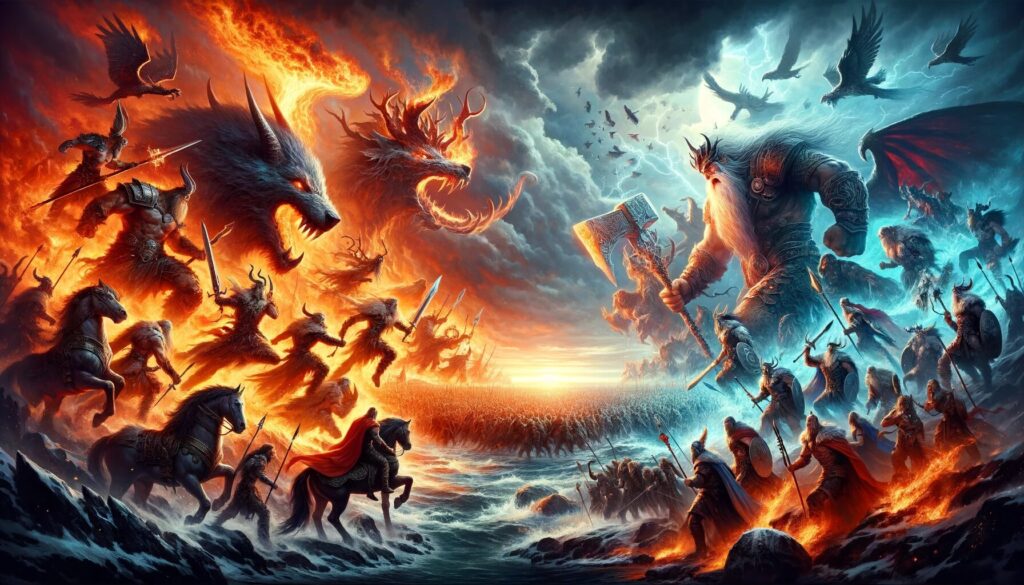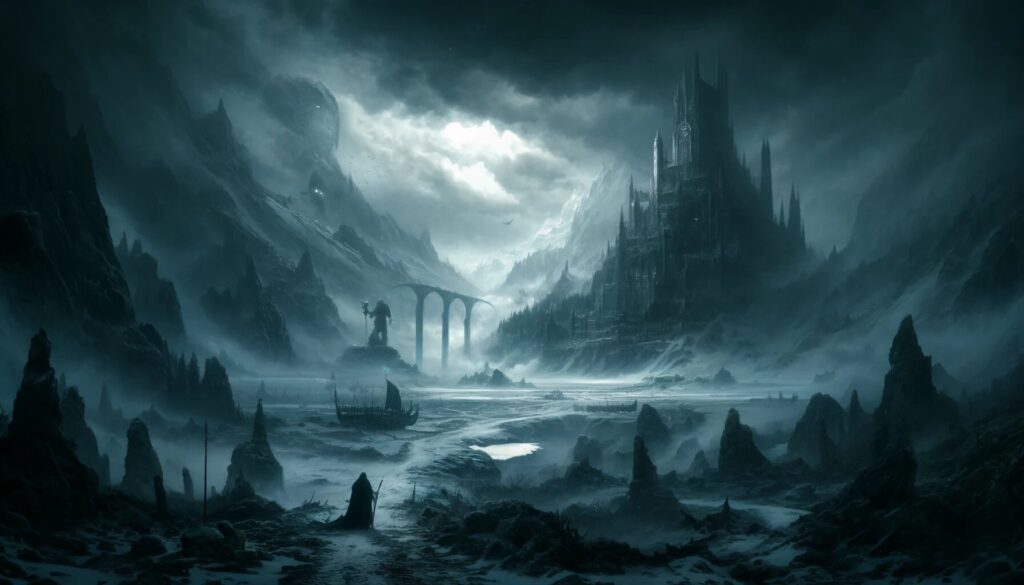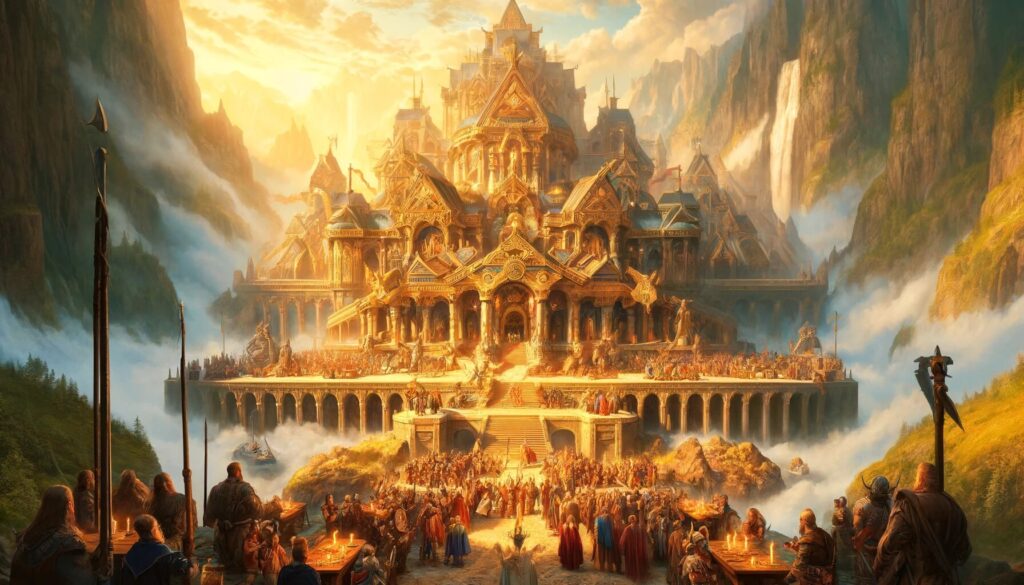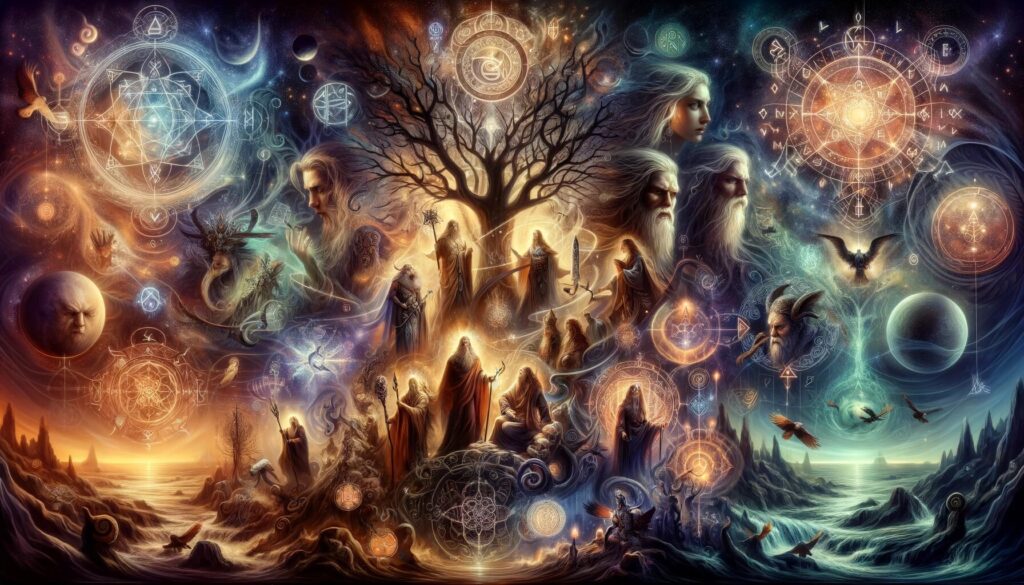Aesir Gods, Baldur, Hel, Hel (The Underworld), Helheim, Loki, Norse Goddesses, Norse Gods, Norse Mythology, Odin, Ragnarok, Tales of the Gods, Thor, Valhalla, Yggdrasil (World Tree)
Did Norse Gods Die?
In Norse mythology, the fate of the gods is a topic of intrigue. If you have ever wondered how long do Norse gods live or why did Norse mythology end, you are in the right place. Stay tuned for more fascinating details.
The Immortality of Norse Gods
In Norse mythology, the gods are often portrayed as long-lived beings with extraordinary powers. The concept of immortality is deeply woven into their stories, giving them a sense of timelessness and eternal existence.
While the gods’ lifespans are not explicitly stated in the myths, they are believed to enjoy significantly longer lives than mortal beings. The gods possess supernatural abilities and are immune to many of the afflictions that affect humans.
One key factor contributing to the perception of their immortality is their association with Asgard, the realm of the gods. Asgard is described as a realm that exists outside of ordinary time and space, allowing the gods to transcend the limitations of mortality.
Additionally, the gods’ divine nature grants them the ability to regenerate and heal from injuries that would be fatal to humans. They are often depicted as resilient and capable of enduring even the most severe wounds.
The immortality of the gods is further reinforced by their connection to powerful artifacts and divine symbols. These objects, such as Thor’s hammer, Mjolnir, and Odin’s spear, Gungnir, are said to bestow immortality upon their wielders. By possessing such artifacts, the gods solidify their status as immortal beings.
The portrayal of the gods’ immortality in Norse mythology reflects their grandeur and power. It elevates them above mortal beings and establishes them as superior beings we can only aspire to become.
Ragnarok: The End of Norse Mythology
Ragnarok, the apocalyptic event in Norse mythology, marks the cataclysmic conclusion of the gods’ existence. This monumental event serves as the driving force behind the end of Norse mythology itself.
During Ragnarok, the world is engulfed in chaos and destruction. The gods face their ultimate demise as they engage in fierce battles against powerful enemies. This climactic confrontation leads to the downfall of many prominent Norse deities, forever altering the landscape of the mythological realm.

Central to Ragnarok are the prophecies of the Seeress, which foretold the impending doom of the gods and the world. These prophetic visions set the stage for the catastrophic events that unfold during this apocalyptic event.
One of the key factors contributing to the end of Norse mythology is the cycle of life and death. In Norse belief, destruction and rebirth are intertwined in a constant cycle, with Ragnarok representing the ultimate destruction before the possibility of a new beginning.
Furthermore, Ragnarok serves as a culmination of the conflicts and struggles between the gods and their adversaries. It symbolizes the end of an era and paves the way for a new age, free from the influences of the old gods.
While the events of Ragnarok signify the end of the gods’ existence, they also hold symbolic significance. The cataclysmic battle and subsequent destruction represent the cyclical nature of life, reminding individuals of the impermanence of all things, even the powerful and immortal gods.
In conclusion, Ragnarok acts as the catalyst for the end of Norse mythology. This epic event signifies the culmination of prophecies, the cycle of life and death, and the symbolic transformation of the mythological world. Once revered and immortal, the gods meet their fateful demise, leaving behind a legacy that continues to captivate and inspire to this day.
How Did the Norse Gods Die: The Death of Odin
In Norse mythology, Odin, the Allfather and ruler of Asgard, is a central figure whose death holds significant implications for the rest of the gods. While there are variations in the accounts of Odin’s death, one common belief is that he sacrificed himself to gain knowledge of the runes, the ancient Norse alphabet, and the magical system.
According to one myth, Odin hung himself from the world tree, Yggdrasil, for nine days and nights without food or water, piercing his own side with his spear. During this self-imposed sacrifice, he discovered the secrets of the runes. However, this act of self-sacrifice ultimately led to his death.
Another version of Odin’s death involves his confrontation with the monstrous wolf Fenrir during Ragnarok. Fenrir was prophesied to kill Odin during the cataclysmic battle. Despite his fate, Odin bravely faced the beast, knowing that his death was inevitable.
Odin’s death carries symbolic significance within Norse mythology. His sacrifice for knowledge and the greater good reflects the theme of selflessness and the pursuit of wisdom at any cost. Additionally, his death marks the beginning of the end for the gods, foreshadowing the impending doom of Ragnarok.
The death of Odin raises questions about the mortality of the Norse gods. While his demise suggests that these powerful beings are subject to death, it is important to note that Norse mythology also includes themes of rebirth and cyclical renewal. This notion of death and rebirth adds complexity to understanding the gods’ immortality.
Overall, Odin’s death is pivotal in Norse mythology, highlighting the gods’ sacrifice, wisdom, and mortality. This section has explored various accounts of Odin’s death and its broader implications for the rest of the pantheon.
The Fate of Thor and Loki
Thor and Loki, two iconic figures in Norse mythology, have captivated readers and viewers alike with their heroic adventures and complex relationship. While their respective fates diverge, the question of whether they met their ultimate demise lingers. Did the Norse gods die? Let’s explore the fate of Thor and Loki.
Thor, the mighty god of thunder, is often portrayed as the protector of Asgard, joined by his trusty hammer, Mjolnir. Despite his tremendous strength and heroism, Thor’s fate is not without ambiguity. Some sources suggest that Thor valiantly battles his enemies during the apocalyptic event known as Ragnarok, only to perish in the cataclysmic conflict that engulfs the Nine Realms.
On the other hand, Loki, the mischievous shape-shifter, walks a treacherous path. While he initially aligns himself with the gods, his unpredictable nature often places him at odds with them. In some accounts, Loki plays a pivotal role in triggering Ragnarok, leading to his own demise along with many other gods. This tragic end underscores the complex nature of Loki’s character and the consequences of his actions.
While it seems plausible that Thor and Loki’s fate ultimately leads to their demise, Norse mythology is known for its intricate narratives and twists. The cycles of death and rebirth observed in the mythology also raise questions about the true extent of their mortality. Could there be a possibility for their resurrection or reincarnation? The answers lie within the rich tapestry of Norse folklore.
As we continue to unravel the mysteries of Norse mythology, we gain deeper insights into the fate of its renowned gods. Whether Thor and Loki met their end or embarked on a new chapter of existence, their compelling stories continue to fascinate and inspire, ensuring their legacy endures through the ages.
Hel and the Realm of the Dead
In Norse mythology, the realm of the dead is governed by Hel, the ruler of Helheim, a dark and mysterious underworld. Hel is closely associated with the concept of mortality and the fate of the gods after their deaths. According to Norse mythology, when a god dies, they journey to Helheim to await Ragnarok, the cataclysmic event that brings about the end of the gods.

The role of Hel in Norse mythology is intricate and multi-faceted. She serves as a guardian of the dead, ensuring their peaceful rest in Helheim. However, it is important to note that Hel is not necessarily the cause of the gods’ deaths but rather the overseer of their afterlife. While the notion of death and the realm of the dead may imply the mortality of the gods, it is essential to understand that death in Norse mythology holds deeper symbolic significance.
The image above depicts Hel, Helheim’s ruler, surrounded by her realm’s somber environment. The image serves as a visual representation of the connection between Hel and the gods’ mortality, emphasizing the solemnity and mystery of the realm of the dead.
Symbolism and Interpretation
Norse mythology often uses symbolic language to convey deeper meanings and philosophical concepts. The realm of the dead, governed by Hel, can represent the cyclical nature of life and death. After their deaths, the gods’ journey to Helheim signifies the inevitable cycle of existence, where death gives way to rebirth. This symbolism suggests that the gods’ mortality is not an end in itself but rather a part of a larger cosmic cycle.
Moreover, Hel’s role as the ruler of the realm of the dead also signifies the importance of death in Norse mythology. Death and the afterlife are not feared or shunned but are recognized as integral aspects of the natural order. Through the symbolism of Hel and the realm of the dead, Norse mythology explores the complex relationship between mortality, rebirth, and the eternal nature of the gods.
- Hel, the ruler of Helheim, presides over the realm of the dead in Norse mythology.
- The gods journey to Helheim after their deaths to await Ragnarok.
- The realm of the dead symbolizes the cyclical nature of life and death.
- Death is not feared but accepted as a natural part of the cosmic order in Norse mythology.
Valhalla and Immortality
Valhalla, the majestic hall in Asgard, is prominent in Norse mythology. It is believed to be the final resting place for fallen heroes and warriors who achieved great feats in battle. Within the walls of Valhalla, these chosen warriors are said to spend their afterlife feasting and preparing for the epic battle of Ragnarok.
The concept of Valhalla raises intriguing questions about the immortality of the Norse gods. If Valhalla is reserved for those who have perished in battle, does it imply that the gods themselves are mortal and eventually meet their demise?
The answer to this question is open to interpretation within Norse mythology. Valhalla, while associated with the death of mortals, does not necessarily indicate the mortality of the gods. Instead, it represents a cycle of life and death, where fallen warriors are rewarded for their bravery in battle.

Valhalla serves as a testament to the honor and glory bestowed upon these fallen warriors, highlighting their importance in the cosmic balance of Norse mythology. While the gods may face various challenges and obstacles, Valhalla is evidence of their enduring presence and eternal legacy.
As with many aspects of Norse mythology, the concept of immortality is multifaceted. While the gods may not be immortal in the traditional sense, their influence and significance endure through the tales and traditions passed down through generations.
Thus, with its grandeur and symbolism, Valhalla offers a glimpse into the intricate tapestry of Norse mythology, preserving both the memory of fallen warriors and the eternal nature of the gods.
The Cycle of Rebirth
Norse mythology is deeply rooted in cyclical themes, highlighting the concept of rebirth. This notion has a significant impact on how one perceives the mortality of the gods.
According to Norse beliefs, death is not seen as the end but rather a part of an eternal cycle. When a god dies, they are not completely eradicated but rather undergo a transformation, paving the way for a new beginning.
This idea of rebirth is exemplified in the story of the god Baldr. Baldr, known for his beauty and purity, was mistakenly slain by his brother, Hodr. However, he is believed to be reborn after Ragnarok, the cataclysmic event that signals the end of the gods and the world as we know it.
Similarly, the goddess Idunn, who possessed the golden apples of youth that granted immortality to the gods, is also subject to the cycle of rebirth. Although she faced death at the hands of the giants, her resurrection is prophesied, ensuring continuity in the cycle.
The Role of Yggdrasil
Central to the concept of rebirth is the mythical tree Yggdrasil, often referred to as the World Tree. It symbolizes the interconnectedness of all worlds and serves as a conduit for the gods’ cyclical existence.
Yggdrasil’s roots delve into the realms of death and regeneration, fostering the cyclic renewal of life. The gods maintain their immortality through this tree, continuously undergoing life, death, and rebirth cycles.
The Significance of Rebirth
The emphasis on rebirth in Norse mythology serves multiple purposes. It reinforces the idea that the gods are not subject to permanent demise but instead endure a perpetual cycle of existence.
This concept also aligns with the natural world, where life emerges from death, and new beginnings follow periods of darkness and decay. By incorporating this cyclical nature into the gods’ stories, Norse mythology reflects life’s inherent ebb and flow.
Therefore, while the gods may experience temporary death, their ultimate destiny is one of rebirth and renewal. Through this continual cycle, they ensure the preservation of their divine power and the enduring legacy of Norse mythology.
Symbolic Deaths in Norse Mythology
In Norse mythology, death takes on various forms, including symbolic deaths that represent transformative experiences for the gods. These metaphorical deaths serve as pivotal moments in the gods’ journey and often foreshadow their ultimate fate.
One such example is the story of Baldr, the beloved son of Odin and Frigg. Baldr’s death is a recurring theme in Norse mythology, symbolizing the vulnerability and impermanence of even the mightiest of gods. According to the myth, Baldr’s death is brought about by a mistletoe arrow, a seemingly harmless object that becomes a powerful tool of destruction. This tragic event catalyzes the onset of Ragnarok, the apocalyptic battle that marks the end of the gods’ reign.
Another symbolic death is that of Skadi, the goddess of winter and the hunt. Skadi is depicted as a fierce warrior who experiences a transformative experience after the gods kill her father, Thiazzi. Seeking revenge, Skadi demands justice and ultimately finds solace in the realm of the gods. Her journey represents the cycle of life and death, where even the gods must face their own mortality.
The gods’ symbolic deaths in Norse mythology serve as reminders of the fragile nature of existence. These stories illustrate the transient nature of power and the inevitability of change. Through their metaphorical deaths, the gods experience profound transformations, shaping the narrative of Norse mythology and providing insights into the mysteries of life and death.
The Significance of Symbolic Deaths
The symbolic deaths in Norse mythology serve multiple purposes. Firstly, they emphasize the cyclical nature of life, reinforcing the notion that death is a natural part of the cosmic order. Additionally, these deaths highlight the gods’ vulnerability and mortality, challenging the traditional perception of immortality often associated with divine beings.
Furthermore, the symbolic deaths provide lessons and moral teachings. They illustrate the consequences of actions and the importance of balance in the divine realm. By experiencing death and rebirth, the gods gain wisdom and evolve, contributing to the ever-changing tapestry of Norse mythology.
The Gods’ Immortality and Mortality
While the gods in Norse mythology possess remarkable powers and longevity, their immortality is not absolute. The symbolic deaths in their stories remind us that even gods are subject to fate and eventual demise. These deaths signify the gods’ connection to the cycle of life, with each ending paving the way for new beginnings.
The symbolic deaths in Norse mythology add depth and complexity to the gods’ narratives. They invite contemplation on mortality, the transient nature of power, and the transformative potential of death. By embracing these symbolic deaths, we gain a deeper understanding of the gods’ mortality and the profound symbolism embedded within Norse mythology.
Bottom Line
In conclusion, the exploration of various aspects of Norse mythology sheds light on the question of did the Norse gods die. While the gods are often depicted as powerful and long-lived beings, their ultimate fate is not one of immortality. Ragnarok, the apocalyptic event, marks the end of Norse mythology and the gods’ existence.
Accounts of Odin’s death hold significance in Norse mythology, signaling a shift in the balance of power among the gods. Additionally, the fate of Thor and Loki remains uncertain, with potential outcomes suggesting their demise. Furthermore, the role of Hel, the ruler of the realm of the dead, adds to the ambiguity surrounding the gods’ mortality.
Although Valhalla, the hall in Asgard, is associated with fallen warriors and the gods, it does not guarantee their eternal existence. Norse mythology’s emphasis on cyclical themes, including the cycle of death and rebirth, further blurs the line between mortality and immortality for the gods. Symbolic deaths in Norse mythology offer additional insight into the gods’ mortality, highlighting the metaphorical nature of their demise.
In summary, while the Norse gods possess immense power and longevity, their ultimate fate is not one of everlasting life. The exploration of Ragnarok, Odin’s death, the fate of Thor and Loki, the realm of the dead ruled by Hel, and the symbolic deaths in Norse mythology all contribute to the understanding that the gods of Norse mythology are not immortal.

